|
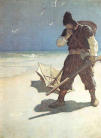
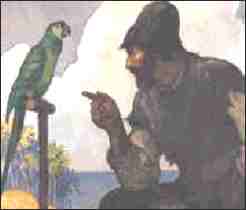
Robinson
Crusoe
is one of the world's most popular adventure novels.
Daniel Defoe based his classic tale of shipwreck and survival on
an uninhabited island, and is based on a true story. The real
Robinson Crusoe was a Scotsman named Alexander Selkirk (or
Selcraig).
Born
in 1676, when Selkirk was 19 years old he was cited for indecent
conduct in church, but before he could be reprimanded, he ran
off to sea. That was in 1695. By 1703 he was the sailing master
of a galley. The following year he joined a pirate expedition to
the Pacific Ocean that was led by Capt. William Dampier.
Selkirk's ship had Thomas Stradling as it's captain.
After
spending some time in the Pacific and numerous raids on the
Spanish towns and shipping, they were preparing to return to
England with their booty. Their ship had suffered considerable
damage in battle and Selkirk felt they needed to repair her
before setting off around the Horn. The captain disagreed. After
a heated argument and in a fit of anger, Selkirk refused to go
any farther and demanded he be set ashore on the Island
of Juan Fernandez, which was about 400 miles off the coast
of Chile. This, the captain was glad to do.
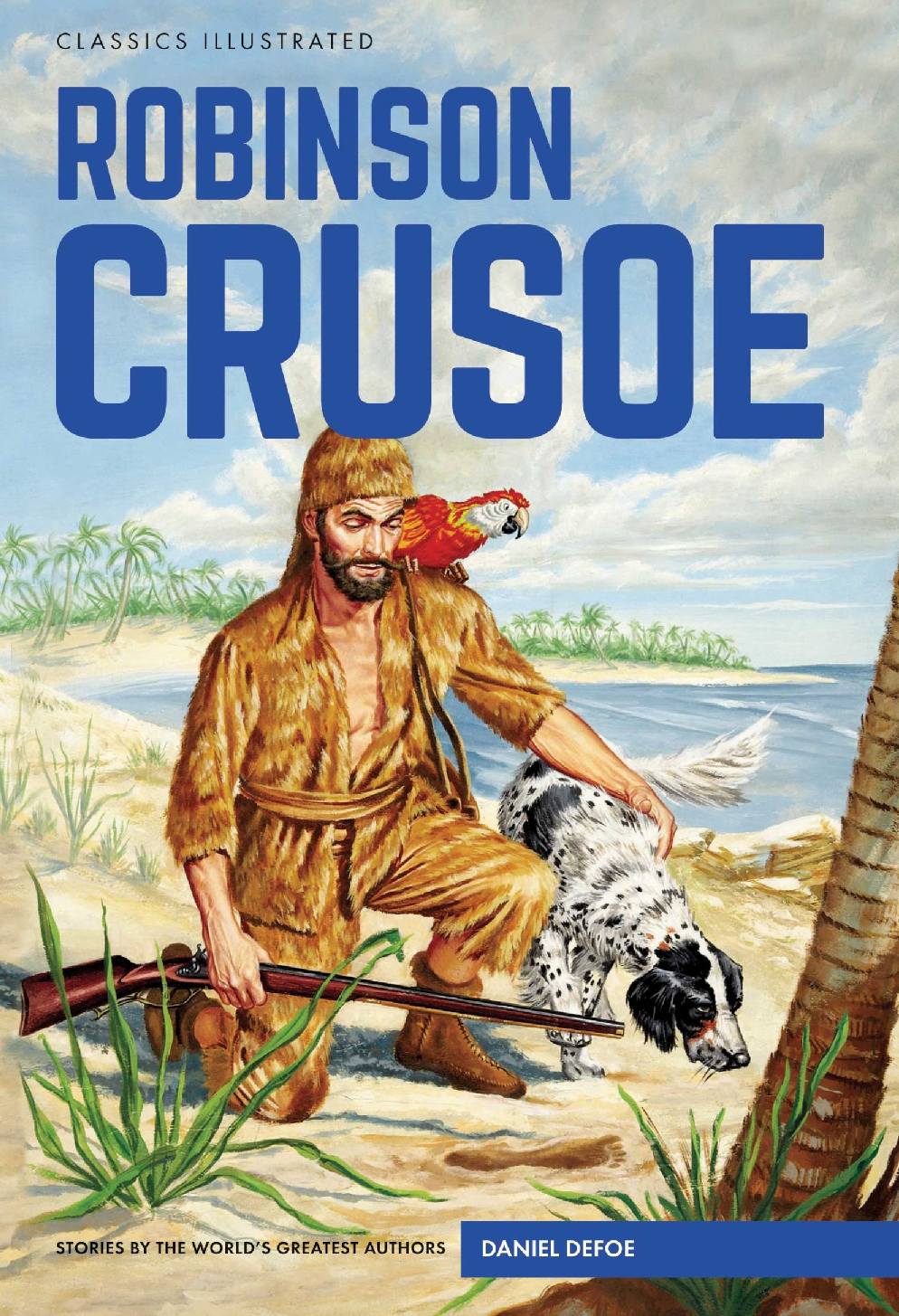
Once
ashore, Selkirk realized the enormity of what he had done. He
thought others in the crew would join him, but none did. He
changed his mind and tried to convince the captain to take him
back. The captain refused and Selkirk found he had marooned
himself alone on an uninhabited island. Actually this was the
smart thing to do since the ship later sank killing most of
those aboard, but at the time he didn't know this.
After
about two years on the island he finally saw a ship and ran down
to the shore to greet it. He realized almost too late that it
was a Spanish ship and the Spaniards opened fire on him as he
ran for cover. They were unable to find him and eventually left.
He was much more cautious after that.
Selkirk
was able to domesticate some goats and cats he found on the
island and these were his only companions though out his stay of
almost 4 1/2 years. He
was finally found in February 1709 by William Dampier, who
was then pilot on a privateering expedition headed by Captain
Woodes Rogers.
Rogers
appointed Selkirk as ship's mate and later gave him command of
captured ship. For the next two years they conducted raids on
the coast of Peru and Chile. They even captured a Spanish
galleon. Selkirk was very well-off when they returned to London
in 1711, as his share of the booty came to £800 - a
sizable fortune in those days. Selkirk soon met essayist Richard
Steele, who wrote up Selkirk's story and published it as
"The Englishman" in 1711.
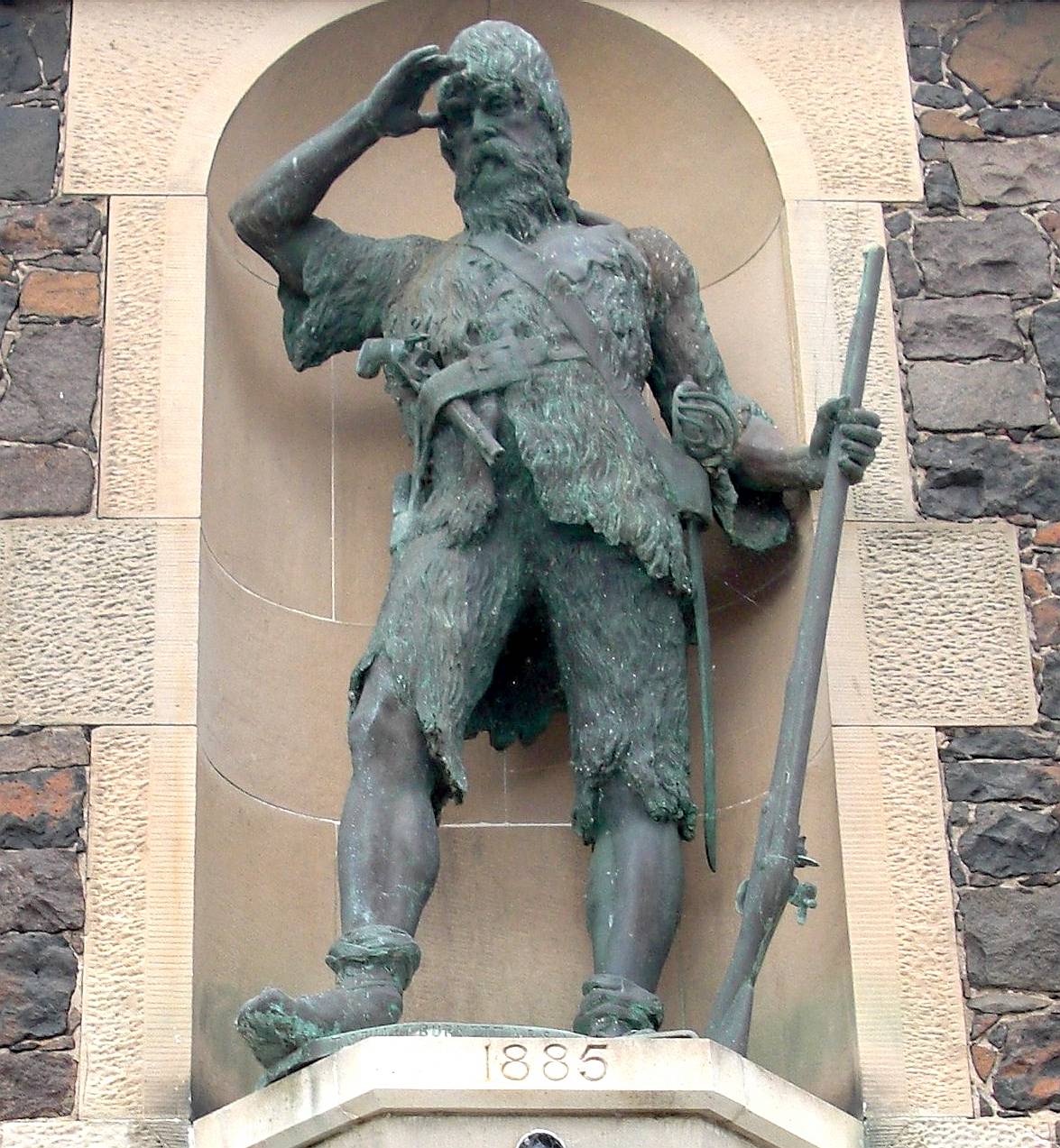
Selkirk
eventually returned to his home in Scotland, where he became
quite a celebrity. Though he did get married, he never quite
recovered from his stay on the island. Spending much of his time
alone, he didn't feel comfortable living indoors and built a
sort of cave or bower behind his father's house that he stayed
in. He also trained two cats to perform little feats, like he
did on the island. Eventually he returned to sea and he died of
fever off the coast of Africa in 1721 at the age of 45.
While
some biographers say Defoe never met Selkirk, others say the two
met at the house of Mrs. Demaris Daniel in Bristol, where
Selkirk told Defoe firsthand of his adventures and even gave
Defoe his personal papers. Either way, there's little doubt
Crusoe is largely inspired by Selkirk. He may have also been in
Robert Louis Stephenson's mind when he wrote of the marooned
pirate Ben Gunn in Treasure
Island.
In
the novel, Defoe extended Selkirk's 4 1/2 years on the island to
Robinson Crusoe's 28 years. He also moved the island from off
the coast of Chile far out in the Pacific Ocean to just off the
coast of Venezuela. In relation to our main interest - which is
pirates and piracy - before Crusoe is shipwrecked on the island
he is captured by Moorish pirates from Sallee on the coast of
Africa, but soon escapes. And while his rescuers are not exactly
pirates, they are in the midst of a mutiny that Crusoe helps put
down and brings them back to the straight and narrow.
Even
though Robinson Crusoe is a fictional character, like Sherlock
Holmes, he has crossed over from fiction to fact in the minds of
some people. There are even people on the Island of Tobago who
claim to be descended from Robinson Crusoe.
Whatever
the effect on people, we found the story to be an inspiring tale of
survival. When the chips are down, humans are at their most adaptable
and inventive. Most boys can identify with this story. It also appeals
to adults who yearn for adventure, to escape their civilized bonds.
Robinson Crusoe is a novel by Daniel Defoe, first published on 25 April 1719. The first edition credited the work's protagonist Robinson Crusoe as its author, leading many readers to believe he was a real person and the book a travelogue of true incidents.
Epistolary, confessional, and didactic in form, the book is presented as an autobiography of the title character (whose birth name is Robinson Kreutznaer) – a castaway who spends 28 years on a remote tropical desert island near the coasts of Venezuela and Trinidad (roughly resembling Tobago), encountering cannibals, captives, and mutineers, before ultimately being rescued.
Despite its simple narrative style, Robinson Crusoe was well received in the literary world and is often credited as marking the beginning of realistic fiction as a literary genre. It is generally seen as a contender for the first English novel. Before the end of 1719, the book had already run through four editions, and it has gone on to become one of the most widely published books in history, spawning so many imitations, not only in literature but also in film, television, and radio, that its name is used to define a genre, the Robinsonade.
By the end of the nineteenth century, no book in the history of Western literature had more editions, spin-offs, and translations (even into languages such as Inuktitut, Coptic, and Maltese) than Robinson Crusoe, with more than 700 such alternative versions, including children's versions with pictures and no text.
The term "Robinsonade" was coined to describe the genre of stories similar to Robinson Crusoe.
Defoe went on to write a lesser-known sequel, The Farther Adventures of Robinson Crusoe (1719). It was intended to be the last part of his stories, according to the original title page of the sequel's first edition, but a third book was published (1720) Serious Reflections During the Life and Surprising Adventures of Robinson Crusoe: With his Vision of the Angelick World.
Influence on language
The book proved so popular that the names of the two main protagonists have entered the language. During World War II, people who decided to stay and hide in the ruins of the German-occupied city of Warsaw for a period of three winter months, from October to January 1945, when they were rescued by the Red Army, were later called Robinson Crusoes of Warsaw (Robinsonowie warszawscy). Robinson Crusoe usually referred to his servant as "my man Friday", from which the term "Man Friday" (or "Girl Friday") originated.
Influence on literature
Robinson Crusoe marked the beginning of realistic fiction as a literary genre. Its success led to many imitators, and castaway novels, written by Ambrose Evans, Penelope Aubin, and others, became quite popular in Europe in the 18th and early 19th centuries. Most of these have fallen into obscurity, but some became established, including The Swiss Family Robinson, which borrowed Crusoe's first name for its title.
Jonathan Swift's Gulliver's Travels, published seven years after Robinson Crusoe, may be read as a systematic rebuttal of Defoe's optimistic account of human capability. In The Unthinkable Swift: The Spontaneous Philosophy of a Church of England Man, Warren Montag argues that Swift was concerned about refuting the notion that the individual precedes society, as Defoe's novel seems to suggest. In
Treasure Island, author Robert Louis Stevenson parodies Crusoe with the character of Ben Gunn, a friendly castaway who was marooned for many years, has a wild appearance, dresses entirely in goat skin, and constantly talks about providence.
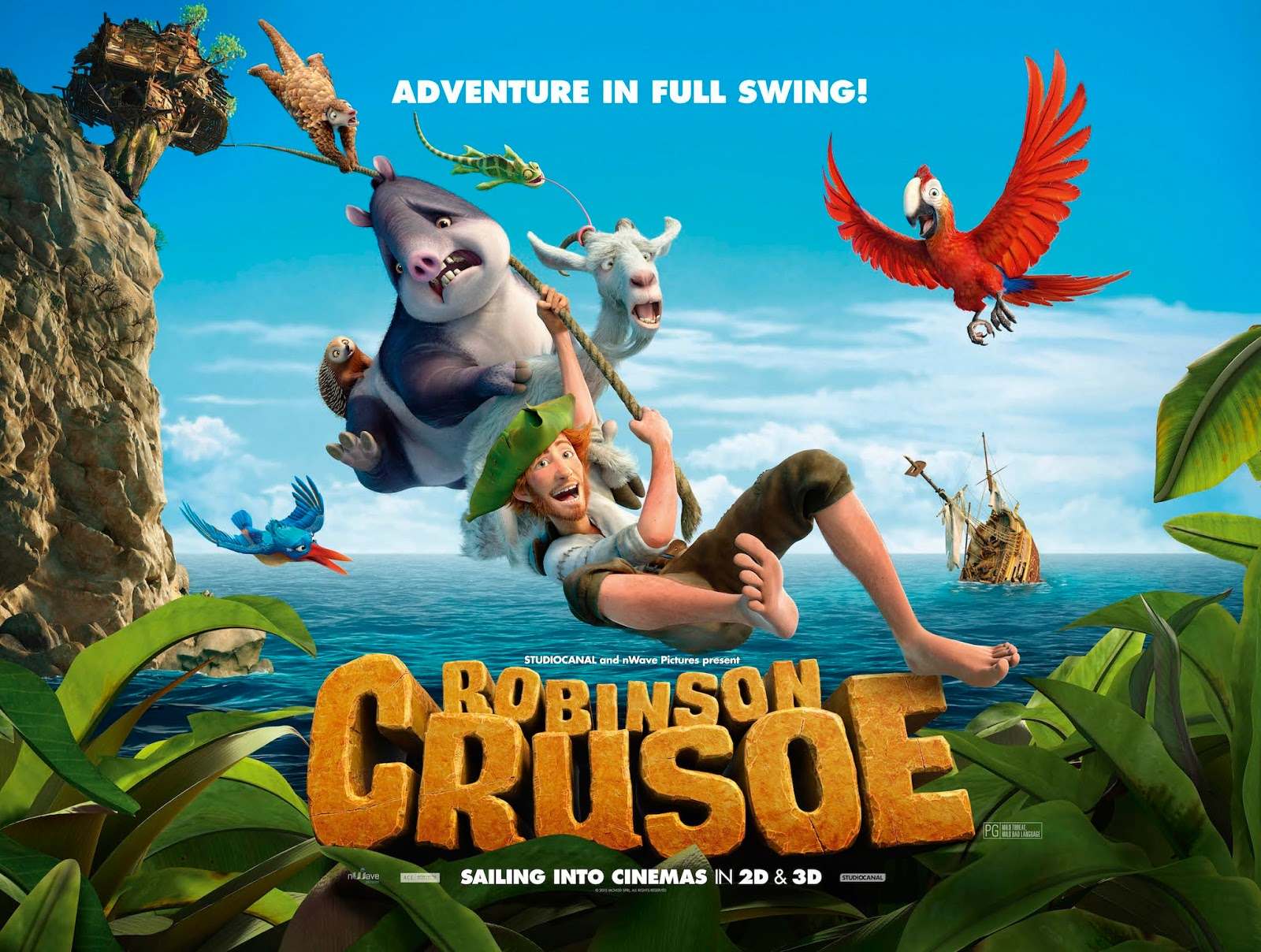
Comics adaptations
The story was also illustrated and published in comic book form by Classics Illustrated in 1943 and 1957. The much improved 1957 version was inked / penciled by Sam Citron, who is most well known for his contributions to the earlier issues of Superman. British illustrator Reginald Ben Davis drew a female version of the story titled Jill Crusoe, Castaway (1950–1959).
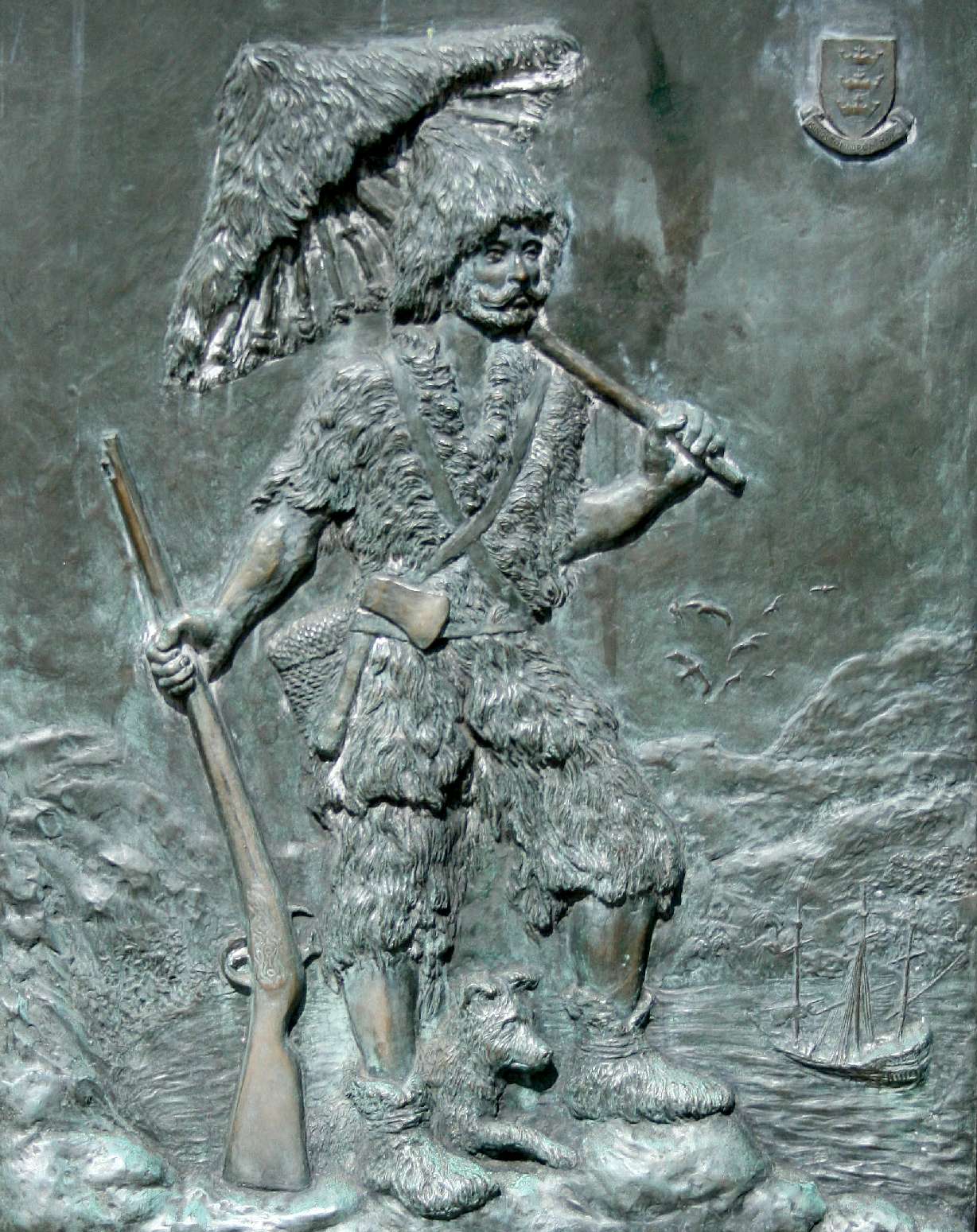
Film adaptations
There is a 1927 silent film titled Robinson Crusoe. The Soviet 3D film Robinson Crusoe was produced in 1947. Luis Buñuel directed Adventures of Robinson Crusoe starring Dan O'Herlihy, released in 1954. Walt Disney later comedicized the novel with Lt. Robin Crusoe, U.S.N., featuring Dick Van Dyke. In this version, Friday became a beautiful woman, but named 'Wednesday' instead.
Peter O'Toole and Richard Roundtree co-starred in a 1975 film Man Friday which sardonically portrayed Crusoe as incapable of seeing his dark-skinned companion as anything but an inferior creature, while Friday is more enlightened and sympathetic. In 1988, Aidan Quinn portrayed Robinson Crusoe in the film Crusoe. A 1997 movie entitled Robinson Crusoe starred Pierce Brosnan and received limited commercial success.
Variations on the theme include the 1954 Miss Robin Crusoe, with a female castaway, played by Amanda Blake, and a female Friday, and the 1964 film Robinson Crusoe on Mars, starring Paul Mantee, with an alien Friday portrayed by Victor Lundin and an added character played by Adam West. The 2000 film Cast Away, with Tom Hanks as a FedEx employee stranded on an island for many years, also borrows much from the Robinson Crusoe story.
In 1964 a French film production crew made a 13 part serial of The Adventures of Robinson Crusoe. It starred Robert Hoffmann. The black and white series was dubbed into English and German. In the UK, the BBC broadcast it on numerous occasions between 1965 and 1977. In 1981 Czechoslovakian director and animator Stanislav Látal made a version of the story under the name Adventures of Robinson Crusoe, a Sailor from York combining traditional and stop-motion animation. The movie was coproduced by regional West Germany broadcaster Südwestfunk Baden-Baden.
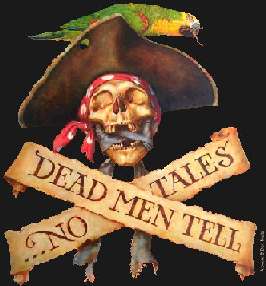
|






